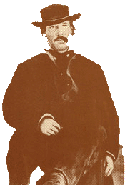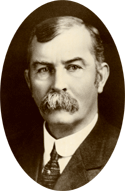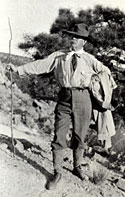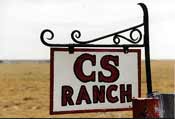A Way of Life Out West.
 In 1941, young Les Davis from Philadelphia was a college senior taking premed classes at Dartmouth. On Jan. 16th of
that year he penned a carefully worded letter to Ed Springer,
who managed the CS Ranch at Cimarron, N.M. In 1941, young Les Davis from Philadelphia was a college senior taking premed classes at Dartmouth. On Jan. 16th of
that year he penned a carefully worded letter to Ed Springer,
who managed the CS Ranch at Cimarron, N.M.
"Dear Uncle Ed - This is my last year at Dartmouth College and in looking
to the future I have, for quite some time, considered the possibility of going
West. An active life, that is, an occupation which involves active physical endeavor,
has always appealed to me."
Davis and his family celebrated his 81st birthday on October 24th, 2000.
But he remembered that time as if it were only yesterday.
"I wasn't winning any medals for scholarship and I thought about this ranch
that my mother's father, Frank Springer, had started," he said. "The
essence of my letter was, 'what about me coming out there and trying to learn
the horse and cattle business?'"
Uncle Ed answered by return mail, "Come on out."
By the time those letters were exchanged, the CS was already 68 years old.
 The CS Ranch was founded in 1873 by Frank Springer. It is situated at the
foot of the Sangre de Cristo mountain range in northern New Mexico with headquarters
near Cimarron. The ranch encompasses 130,000 acres of the 1.7 million acre
Maxwell Land Grant. Frank, with his brother Charles, whose initials are used
for the ranch name and historic brand, built a ranching enterprise that endures
to this day. Les Davis, grandson of Frank Springer, took over management
of the CS in 1947. He and Linda Mitchell married in 1953. Linda brought her
own ranching heritage to the CS. Her father, Albert Mitchell, ran the family
ranch at Albert, New Mexico and managed the famous Bell Ranch from 1933 -
1947. The CS Ranch was founded in 1873 by Frank Springer. It is situated at the
foot of the Sangre de Cristo mountain range in northern New Mexico with headquarters
near Cimarron. The ranch encompasses 130,000 acres of the 1.7 million acre
Maxwell Land Grant. Frank, with his brother Charles, whose initials are used
for the ranch name and historic brand, built a ranching enterprise that endures
to this day. Les Davis, grandson of Frank Springer, took over management
of the CS in 1947. He and Linda Mitchell married in 1953. Linda brought her
own ranching heritage to the CS. Her father, Albert Mitchell, ran the family
ranch at Albert, New Mexico and managed the famous Bell Ranch from 1933 -
1947.

Kim Davis Barmann with
daughters Leslie & Kelly |
Today the CS Cattle Company remains a family business. Warren M. Davis manages the Crow Creek division. Randolph S. Davis handles the elk, mule deer and antelope hunting and the Headquarters cattle. J. Kirk Davis, since the passing of his father, Les, in 2001 is now president of the corporation and runs the ranch farming operation, along with maintaining the ranch infrastructure. Bruce P. Davis manages the mountain country, the Clayton Place cattle and does the livestock marketing for the ranch. Julia Davis Stafford handles the ranch's strategic planning and legal matters..

Linda & Les Davis |
Linda and Les Davis dedicated their lives to their family, the CS and the
livestock industry. Their success was recognized in 2000 when both
were inducted into the Hall of Great Westerners at the National
Cowboy and Western Heritage Museum in Oklahoma City. Les passed
away May 12th, 2001. Linda remains active in ranch operations, as an EMT with the Cimarron Volunteer Ambulance Service and continues
with their shared commitments to state and national efforts that foster
western heritage.
CS
Horses
The
CS horse-breeding program began in 1885, tracing its origins
to a visionary but ill-fated horse program played out in the early 1880's
near Cimarron. Frank Sherwin, then president of the Maxwell Land Grant Company, believing the climate of northern New Mexico
to be ideal for thoroughbred horses, purchased 20 of the finest
English mares available. The mares were acquired at a cost
of $1,000 each. Uhlan, a French-bred stallion of flawless
pedigree was purchased for $15,000. The mares and stallion
made the long and difficult trip to New Mexico. Regrettably,
the enterprise failed, Sherwin was fired and the horses sold
at a Sheriff's auction in 1885. Frank Springer purchased two
stallions and a dozen fillies at the sale. This well-bred band
of horses formed the nucleus of the CS Ranch horse program
and produced many foundation horses of the American Quarter
Horse breed.
Over the years, horses have played a major role on this cattle ranch.
During the 1920's the CS Ranch was a supplier to the U.S. Army's Western
Remount Service. The Army furnished the CS several thoroughbred stallions
to cross on their proven mares to produce topnotch mounts for the cavalry.
When the depression tightened its grip on the ranch, causing plummeting
cattle prices, the CS horses, a band of 200 high quality mares and numerous
quarter horse and thoroughbred stallions came to the forefront as a profit
center for the ranch. The CS produced premium all-around ranch horses,
cavalry mounts, hunter-jumpers and polo ponies, setting a new and higher
standard in the western United States.
The CS has been a part of thoroughbred racing in New Mexico since the
late 1930's. Les' uncle, Ed Springer, known as "The Father of Racing
in New Mexico" played a pivotal role in the legislative approval
of pari-mutuel waging. CS thoroughbreds have won 10 New Mexico-bred
futurities, the New Mexico-bred Derby and the State Fair Handicap several
times.
Many high goal polo players across the country such as Tommy Hitchcock,
Tommy Rupert, Lewis Stoddard and Will Rogers favored CS polo ponies. Will
Rogers found that the CS Ranch raised and trained cow ponies had all the
agility, stamina, and level-headedness that was needed to make first-rate
polo ponies. The great demand for CS polo ponies resulted in a rivalry
between cowboys and polo proponents on the ranch for the best mounts.
Jiggs
Porter (1916 - 2005)
Jiggs Porter joined the CS in 1933 and was the long time cow foreman on
the ranch with 63 years of service. Jiggs deserves the credit for training
the six Davis children as stockmen and women and for the continual
improvement of the cattle and horses on the CS. Jiggs' priorities and persuasiveness
are well illustrated by a story from the 1930's. Jiggs had started a
horse named Bootlegger. The horse's potential as a polo pony was noted
by Ed Springer, who told young Porter to bring the horse to headquarters
for sale with the other polo pony prospects. When the day arrived, no Bootlegger.
Jiggs reported to Springer that the colt pulled up lame and was not
sound to ride. To this, Springer squarely addressed Porter and said, "If
he means that much to you, I guess you can just ride him for a while
longer!"
 The CS polo pony program passed with the onset of World War II when the
ranch again focused its attention on cattle production in support of the
war effort. After World War II, the face of horse breeding and agriculture
in the United States changed forever. Mechanization was the order of the
day. The CS horse-breeding program refocused on support of the cattle operation.
This remains the case today, with a broodmare band producing top ranch
horses and replacement fillies. The quality of the operation was recognized
in 2000 when the CS was awarded the AQHA Remuda Award. The CS polo pony program passed with the onset of World War II when the
ranch again focused its attention on cattle production in support of the
war effort. After World War II, the face of horse breeding and agriculture
in the United States changed forever. Mechanization was the order of the
day. The CS horse-breeding program refocused on support of the cattle operation.
This remains the case today, with a broodmare band producing top ranch
horses and replacement fillies. The quality of the operation was recognized
in 2000 when the CS was awarded the AQHA Remuda Award.
|

Crow Creek Division |

Crow Creek Division |
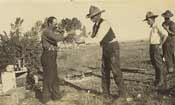
Crow Creek |

Ada Springer |

Bruce, Randy,
Warren & Kirk Davis |

Linda Davis |

Julia Davis Stafford |
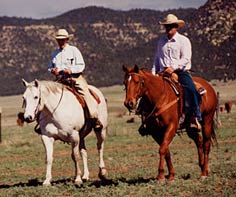
Linda and her son,
Warren Davis |
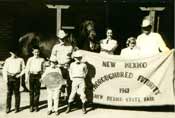
Davis Family
1967
|

Jiggs Porter
CS Foreman 1933-1999 |
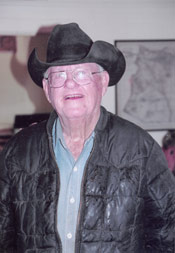
Jiggs Porter (1916 - 2005)
Fall of 2004, 88 Years Young |
|
|


